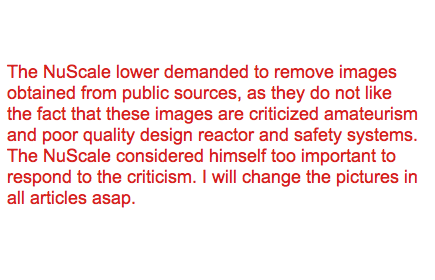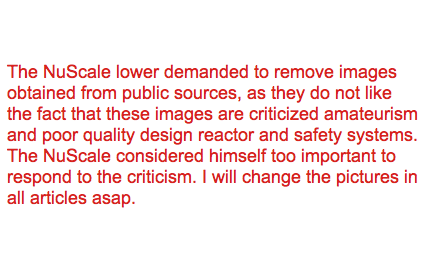If we consider the reasons/causes for which the reactor must be urgently taken out of operating (by scram cause), most of all, they should be divided into several different groups:
- Accidents and failures associated with the reactor’s core work/operating (rho, tau, neutronics power)
- Accidents and failures associated with the primary circuit operating (coolant outcoming high temperature and/or increasing primary pressure in the reactor)
- Accidents and failures associated with the reactor (coolant) leaks of different intensity (coolant level and internal reactor pressure decreasing)
- Accidents related to the turbine part (plant) faults (different reasons, technical or operatings), steam and feed-water (FW) (FW pressure and secondary steam pressure and temperature)
- Accidents related to equipment operating (electric power supply loss and/or failures of important machines, agregates, etc)
- Accidents related to crew operating errors and mistakes.
In amount, all we can consider about 12-15 signals, some of which somehow overlap. For each signal (or group), during scram and cooling process variously operated equipment, which can be used to transient mode power plant unit it to the emergency cooling regime. So, different ways and cooling, emergencies and long-term heat removal process. Let’s do some simple and pretty understandable overview:
- The first two groups have in common is that the power plant (reactor) has no the failure of major equipment and systems, and hence shutdown and heat dissipation can be made rapidly, but in a regular (standard systems and heat removing channels).
- The third group, which includes leaks reasons (small, medium, large, pipes break and/or LOCA), by a strange coincidence, and estimated the designers and inventors are partially not considered (?) for LW-SMR. Specially LOCA.
- The fourth group of the accidents related to faults pumps (FW or Condensate pumps), main condenser (MC), main turbine, pipes breaking off, valves, problems with feed water supply and steam distribution.
- The fifth group related to the blackout not only failure of major equipment (see fourth group), but also to the complete loss of control over the power plant operating and is more worst fourth variant.
- And the sixth group, which we are not discussing here.
So, before we found out that for the safe shutdown procedures (algorithms) of the power plant (reactor) need several heat removal ways (channels). While we do not consider the circulation of primary coolant yet, which is a separate and very interesting point of discussion.
The first channel (normal heat removal process) is the way to drop the steam, steam-water mixture or water (in various regimes) from the steam-generator (SG) through the steam pipes, to the MC. In this case, starting-up feed-water pumps and condensate pumps are working normally, also. And, feed-water going through SG, after going into the MC with pre-wet steam with cold water. Then transient to steam-water mixture regime, and in the end only heating water regime. Electric power connected normally and available, all the power plant supporting systems working normally, also. Residual heat peak removal process is not difficult after this types of scrams. The reactor will be transferred to the normal cooling mode without any problem.
The second channel, if steam lines/pipes has being damaged, SG or condensate – feed-water system, and the MC and/or main cooling system. In this case we need a special backup heat removal channel. In the design variant types like NuScale DHRS (or CAREM (?) for example, etc) it is dropping steam and/or steam-water mixture from the SG to the separate and special heat exchanger (HE) submerged in the huge pool behind the containment and in the organize of a natural circulation (NC) pattern SG-HE. Except for the calculations, in theory there is probably no problem. But once there is a number of questions: What about the level of the primary circuit (again?). And containment when working constantly immersed in the pool? The second question is not so important, probably safety automatically increase if we will put reactor in the pool (sarcastic). But the first question still to be really important. Without a detailed explanation, this is still to be design problem. And US Patient 80,170,173 not actually exist in project any more? O-ops…
Surprise, surprise… we will talk about third way below. Lot of interesting stuff we can find about design’s conception here. The third channel of heat removal be connected up during the most heavy accidents. Organization of cooling water from the water-filled reactor’s containment, to the reactor lower plenum. Is this possible in/with open circulation loop, when the coolant evaporating through pipes with valves on top of the reactor vessel? Evaporated coolant is condensing on the cooled containment walls (which submerged into the pool), the water pour down to the containment bottom. Where, through the open “circulation” pipes with valves (same like on top) falls into dropping the reactor again to the core from bottom, going through the core, heating, partially vaporized and then through the top part of the reactor going out into containment again. Looks good. In theory yet.
Quite a strange scheme CHRS and in terms of engineering reliability and in terms of the heat sink from the core. In terms of equipment fault (turns out) that in addition to the pressure relief/vent steam valve (or two), there are several individually controlled valves (probably, at least 8) on large enough diameters pipes, connecting the internal volume of the reactor with containment cavity (O-ops!!!). Probably 4 on top and 4 below in lower plenum area, just right after the SG (see p. 40 also ).
This design solution is so uncertain and does not hold water, in terms of reliability, and that discussing it “into the air” with no opponents responds not possible. There’s even no LOCA not talk about the absence of which so confidently say the designers of the reactor and this kind of system (sorry, but NuScale again). Interesting to see calculations algorithm. But with opponents, it would be fun to argue. Indeed, there is no connections and target definitions, and several pipes is out, valves faults, well, come off … It happens to everyone.
Again, there is an interesting question for our heat removal from the core and the organization of the primary circulation loop. The truth, in this case, the primary coolant level in the reactor “lost”, and we can not to say exactly, what is going on with the reactor core. What are the risks, designers must also consider.
And, for this kind of design and this kind of technical solutions people can get Government grants? But we are still talk about economy of the SMR here…
(For additional information: www.NuScalePower.com and presentations)




